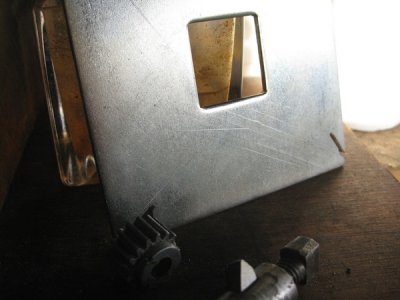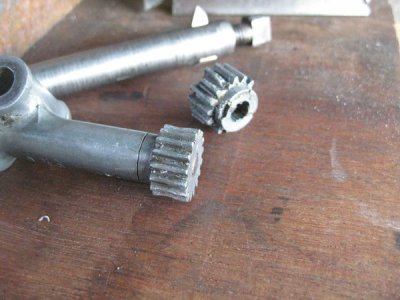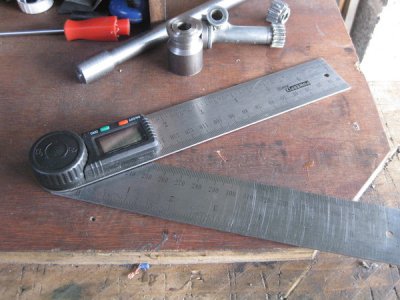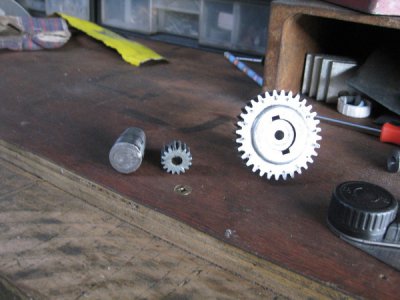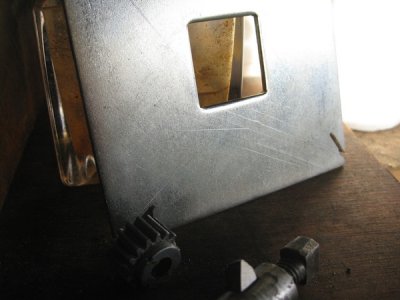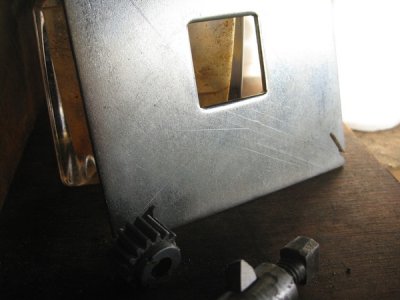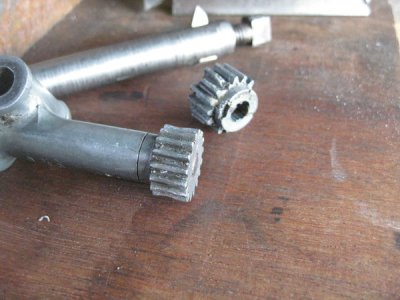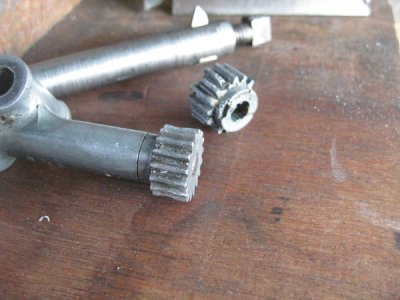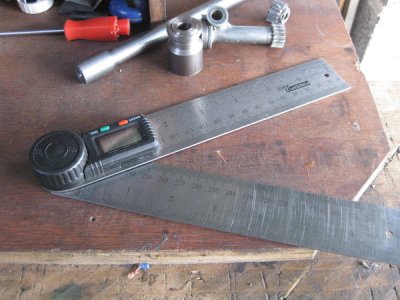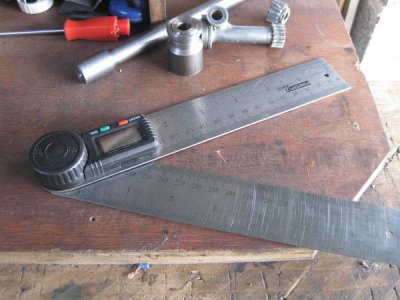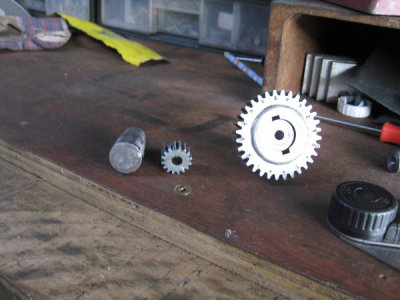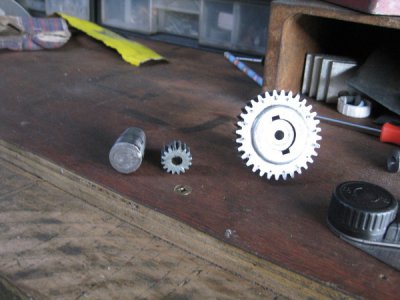- Joined
- Jul 9, 2014
- Messages
- 613
I'm now into making my fifth thread counter gear that turns on the screw shaft of my Sphere cum Atlas lathe.
I tried to faithfully grind the tooth profile on the 1/4 " sq HSS cutter using a bench grinder , daylight and the old Mk 1 eyeball to get the shape , then used my lathe as a shaping machine to gently scrape away the unwanted metal.
This resulted in the tips of the gear being about as thick as a razor blade and getting stripped off within seconds of setting it up in the thread counter body axle & seeing it if worked.
Second version was to use my Dremel to make a micro adjustment to the cutter profile and I still got the same end result of razor sharp fins . The depth is exactly the same as an unworn part of the gear wheel . So I conclude it is the angle of profile of the cutter that too obtuse . I noticed that the sides of the cut teeth are not symmetrical, one side is a tiny bit to one side and slightly hollow along the side . Being central to the point of axis appears spot on . ( I can repeat that alignment easily enough ) .
Again with the third trial ..... not a very good result it engaged whilst the saddle travel was not engaged but came free of the screw thread as soon as I've engaged the feed lever ..
Perhaps this suggesting that it is not in deep enough engaged or it's teeth are at the wrong angle ( Your thought appreciated here please )
My hands and arms are now beginning to fatigue somewhat from all the hand turning of the hand wheels these last few days so I've decided to try to use my boring bar to make a small fly cutter and to mount the gear blank in the boring bar tool holder of the QCTP. I also tried to tidy up the tip of the fly cutter with the Dremel
I've made the fourth wheel .
I'm getting good at using a 32 toothed wheel to cut the 16 tooth wheel using the boring bar holder in the QCTP , made a very pointed pointer that fixes to the height adjuster of the boring bar holder . When set up , it throws a needle point shadow that's easily seen on the top edge of a tooth on the 32 tooth wheel ...so the spacing of the teeth is reasonably accurate .
Clamping solid is also very effective now I've used new real high tensile steel clamping screws not the ones made out of cheese that came with the thing. ( One sheared off with just a two finger tightening pull ) .
I cut the full set of teeth as things were looking very good however on getting round to cutting the last tooth I found it was out by about 20 thou and as a result has shaved the last tooth away to yet another razor thin thickness. I've put this last tooth problem down to not rotating the master wheel in the same direction all the time., as when I cut the first three teeth I found there is a slight play in the fit of the shaft in the QCTP holder ( I'll be making a better one tomorrow ) .
I also found that the profile of the teeth is not as good a shape as I thought it would be.
The test /trial run has again resulted in the gear riding out of the acme screw thread which again indiacted I've got the wrong tooth profile /angle angle .
Looking at the original gear tooth profile with a magnifying glass , it's indicated that the teeth sides are straight sides of a triangle ,the tips are very slightly rounded at a 1 mm radius and the tooth root floor is flat
Are any of you ingenious guys using some sort of simple hand made device that can grip or guide the HSS blank to give me a symmetrical 60 degree angle on the blank when I use it on the grind stone ?
OR
Have any of you guys and gals got any tips of how to do it ?
OR
Have you any other suggestions as to how to make the gears ?
Bearing in mind I only have a lathe , a drill press ,some hand files , an angle grinder , a Dremel , a 4 "table top mounting vice & spanners ( aka . wrenches )
I tried to faithfully grind the tooth profile on the 1/4 " sq HSS cutter using a bench grinder , daylight and the old Mk 1 eyeball to get the shape , then used my lathe as a shaping machine to gently scrape away the unwanted metal.
This resulted in the tips of the gear being about as thick as a razor blade and getting stripped off within seconds of setting it up in the thread counter body axle & seeing it if worked.
Second version was to use my Dremel to make a micro adjustment to the cutter profile and I still got the same end result of razor sharp fins . The depth is exactly the same as an unworn part of the gear wheel . So I conclude it is the angle of profile of the cutter that too obtuse . I noticed that the sides of the cut teeth are not symmetrical, one side is a tiny bit to one side and slightly hollow along the side . Being central to the point of axis appears spot on . ( I can repeat that alignment easily enough ) .
Again with the third trial ..... not a very good result it engaged whilst the saddle travel was not engaged but came free of the screw thread as soon as I've engaged the feed lever ..
Perhaps this suggesting that it is not in deep enough engaged or it's teeth are at the wrong angle ( Your thought appreciated here please )
My hands and arms are now beginning to fatigue somewhat from all the hand turning of the hand wheels these last few days so I've decided to try to use my boring bar to make a small fly cutter and to mount the gear blank in the boring bar tool holder of the QCTP. I also tried to tidy up the tip of the fly cutter with the Dremel
I've made the fourth wheel .
I'm getting good at using a 32 toothed wheel to cut the 16 tooth wheel using the boring bar holder in the QCTP , made a very pointed pointer that fixes to the height adjuster of the boring bar holder . When set up , it throws a needle point shadow that's easily seen on the top edge of a tooth on the 32 tooth wheel ...so the spacing of the teeth is reasonably accurate .
Clamping solid is also very effective now I've used new real high tensile steel clamping screws not the ones made out of cheese that came with the thing. ( One sheared off with just a two finger tightening pull ) .
I cut the full set of teeth as things were looking very good however on getting round to cutting the last tooth I found it was out by about 20 thou and as a result has shaved the last tooth away to yet another razor thin thickness. I've put this last tooth problem down to not rotating the master wheel in the same direction all the time., as when I cut the first three teeth I found there is a slight play in the fit of the shaft in the QCTP holder ( I'll be making a better one tomorrow ) .
I also found that the profile of the teeth is not as good a shape as I thought it would be.
The test /trial run has again resulted in the gear riding out of the acme screw thread which again indiacted I've got the wrong tooth profile /angle angle .
Looking at the original gear tooth profile with a magnifying glass , it's indicated that the teeth sides are straight sides of a triangle ,the tips are very slightly rounded at a 1 mm radius and the tooth root floor is flat
Are any of you ingenious guys using some sort of simple hand made device that can grip or guide the HSS blank to give me a symmetrical 60 degree angle on the blank when I use it on the grind stone ?
OR
Have any of you guys and gals got any tips of how to do it ?
OR
Have you any other suggestions as to how to make the gears ?
Bearing in mind I only have a lathe , a drill press ,some hand files , an angle grinder , a Dremel , a 4 "table top mounting vice & spanners ( aka . wrenches )


